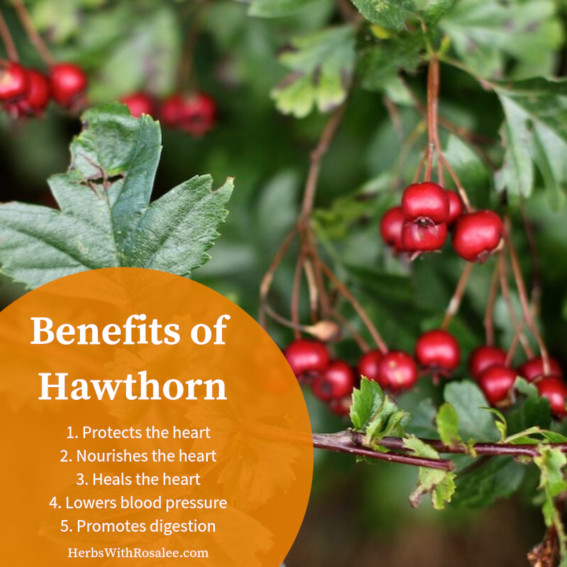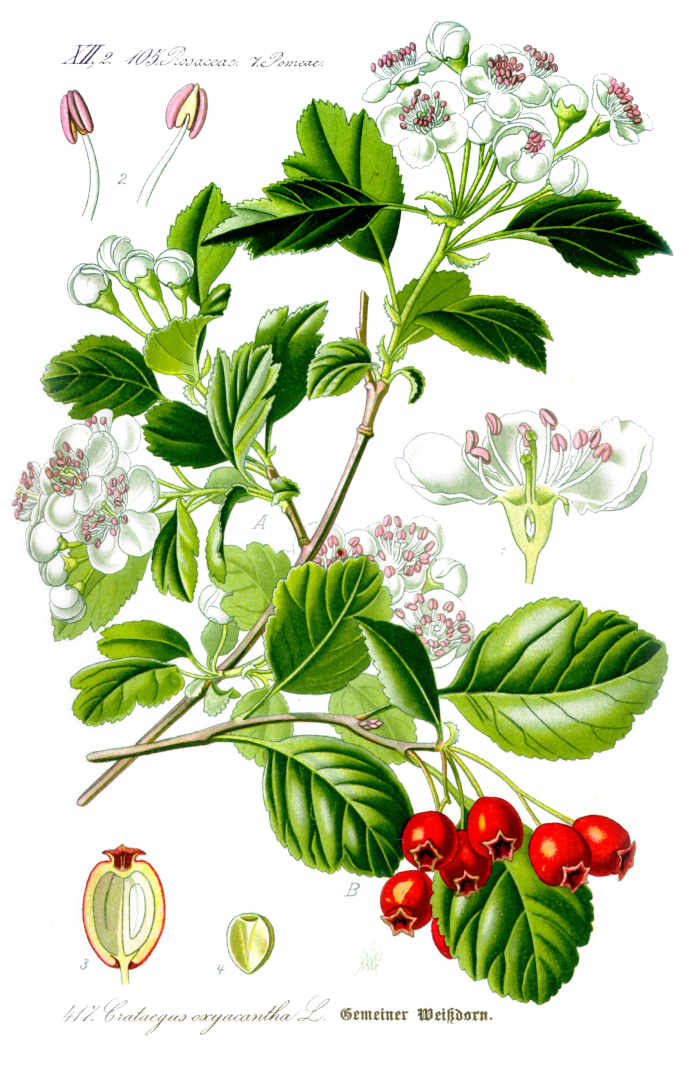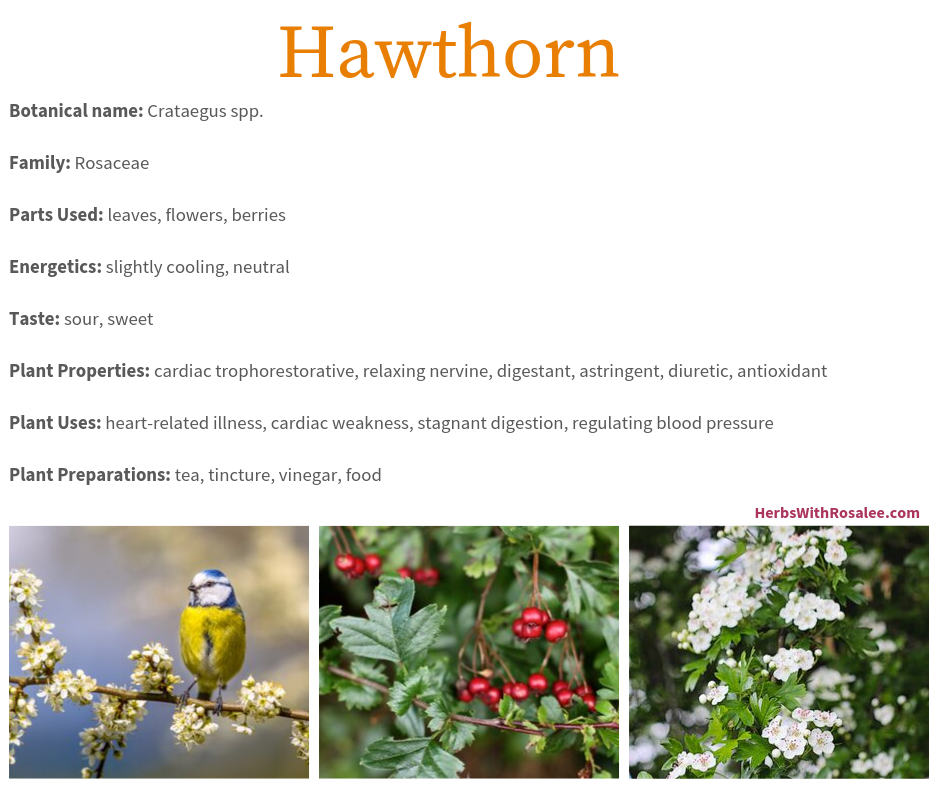Get weekly tips, recipes, and my Herbal Jumpstart e-course! Sign up for free today.

The Hawthorn Herb
Share this! |
|
There are so many hawthorn herb benefits! In this episode, you’ll see how nourishing hawthorn is for the heart and for chronic inflammation. I’ll also share my favorite hawthorn berry extract recipe—it’s so yummy (and so good for you), it’ll be hard to keep enough in the house! By the end of this episode, you’ll see why I’m excited every year when the hawthorn fruit is ripe!
After this episode, you’ll know:
► Why hawthorn berry (or fruit) is a great herb for almost everybody…and who should consult with an herbalist before they start working with hawthorn
► What herb I like to pair hawthorn with for support during times of grief or heartbreak
► What makes hawthorn a potential ally for people with Type 2 diabetes (and what else you need to know before seeking to reverse Type 2 diabetes holistically)
► How hawthorn may help to support a healthy gut flora
-- TIMESTAMPS --
- 00:00 - Introduction to hawthorn berry benefits
- 03:17 - Hawthorn berry energetics
- 03:51 - Hawthorn for the physical heart
- 05:47 - Hawthorn for the emotional heart
- 06:13 - Hawthorn berries for digestion
- 07:13 - Hawthorn berries may help those with Type 2 diabetes
- 08:40 - Hawthorn berries and cancer research
- 09:08 - How to identify hawthorn (Crataegus monogyna)
- 10:36 - Special considerations for hawthorn berry
- 10:57 - Hawthorn berry extract recipe
- 13:53 - Hawthorn Fun Fact
Download Your Recipe Card!
l
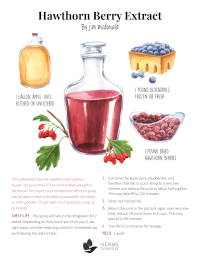
Transcript of the Hawthorn Herb Video
Years ago I spent a couple weeks in rural Ireland where I fell in love with hedges. Lining the roads and fields, these boundaries of stone walls and plants are teeming with life.
The shrubs of the Hawthorn herb were some of the most prominent plants along the hedges, sometimes growing close to the stones, other times shooting far beyond the original stone fence. I walked along those hedges for miles and miles, infatuated with the abundance of hawthorn’s red berries, the gnarly and textured branches, and the many haphazard spines.
I snapped photo after photo, thinking to myself, “What a beautiful world we live in to have such abundant heart medicine growing just outside people’s front doors.”
In European traditions, the hawthorn herb is immersed with mystery and folklore. In the spring its branches are filled with white to pink blossoms that attract countless pollinators. The scent of the flowers has been described as everything from death and decay to divine and erotic. Depending on the location, hawthorn is often found blooming in late April and early May and has long been associated with Beltane, the cross quarter holiday between the spring equinox and summer solstice.
Do you have experience with hawthorn herb benefits? I’d love to hear about it in the comments at the bottom of this page. Your comments mean a lot to me! I love cultivating a community of kind-hearted plant-loving folks! Plus, it’s always interesting and insightful to hear the experiences of plant lovers out there. Your suggestion may also help others!
Okay, let’s dive in..
Hawthorn Berry Energetics
One of hawthorn berry’s benefits is that they are fairly neutral energetically. They may be slightly cooling, but not much. They aren’t considerably dry or moist. This helps to make hawthorn berry a fabulous herb for practically everyone no matter their energetic constitution or whether or not they tend to run cool or hot, or damp or dry.
Overall hawthorn berry is nourishing and protective, a wonderful herb to rely on both as food and as medicine.
The Hawthorn Herb for the Physical Heart
One of the most well known hawthorn herb benefits is for the heart. Hawthorn berries are easily our most beloved herb for the heart. And while we can classify it with a handful of medicinal herbal actions, such as anti-hypertensive, anti-anginal, or anti-cholesterolemic, a better understanding is that the hawthorn herb nourishes and protects the heart. As a result, hawthorn’s virtues benefit a wide variety of heart-related problems.
Modern research has focused on hawthorn’s effects on the physical heart. Large long-term and short-term studies have shown that the hawthorn herb offers many benefits for people who already have mild to moderate heart disease. Studies have specifically shown improvement for ankle edema, general cardiac performance, reduced blood pressure, cholesterol, fatigue, pain with increased exertion, and palpitations.1,2,3,4,5 Researchers have concluded what herbalists have long known, that “hawthorn has a clear benefit for patients with mild to moderate heart failure.”6
How does hawthorn provide so many benefits for the heart? Like most herbs, hawthorn works in many ways, some of which we may never fully understand. Here’s what we do know.
Hawthorn is rich in flavonoids that are known to protect the cardiovascular system.7 Much of the heart disease in the western world is related to chronic inflammation. Regularly enjoying herbs and foods high in these flavonoids can protect the heart from oxidative stress.
If you’re interested in learning more about how herbs can help you protect against oxidative stress and chronic inflammation then check out my online course, Cooling Inflammation.
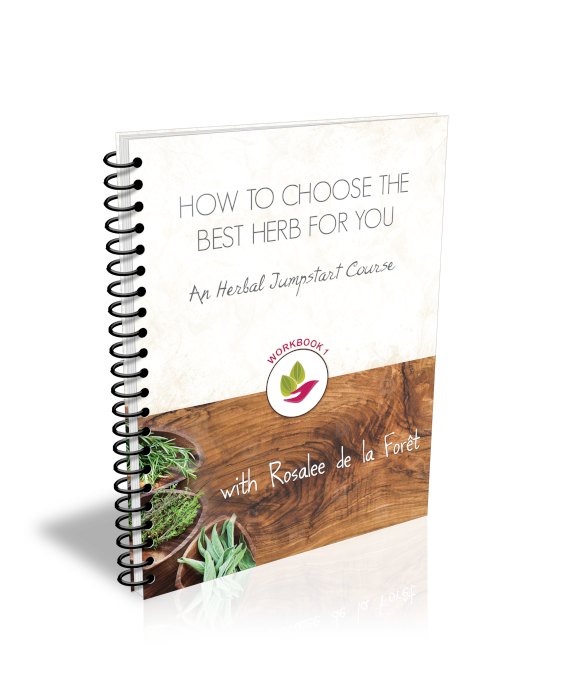
Choose the Best Herb for You!
The secret to using herbs successfully begins with knowing who YOU are.
Get started by taking my free Herbal Jumpstart e-course
By signing up for my free course you’ll also be joining my weekly newsletter where I send my best tips and herbal recipes. I never sell your information and you can easily unsubscribe at any time.
The Hawthorn Herb for the Emotional Heart
Hawthorn not only protects the physical heart in ways that we can objectively measure, such as blood pressure and cholesterol levels, it also nourishes and soothes the spiritual and emotional heart. Herbalists regularly use the hawthorn herb as a general relaxing nervine, as well as for heartbreak and grief. I like to pair it with rose petals for extra heart comfort.
The Hawthorn Herb for Digestion
While hawthorn presently is most famous for its benefits for the heart, it was historically more often used for digestion. In Chinese Medicine the traditional indication for hawthorn berries was for indigestion caused by food stagnation, especially in relation to too much greasy food and meat.8
Pedanius Dioscorides (c. 40-90 CE) and Adam Lonicer (1528-1586 CE) both used the berries for diarrhea.9 In his book, Planetary Herbology, Michael Tierra recommends the green fruit for diarrhea and the roasted and charred fruits for both diarrhea and dysentery-like disorders.10
There is some initial research that shows that constituents of hawthorn berries may help to positively modulate gut flora and help to produce short chain fatty acids.11
Hawthorn Berries May Help Those with Type 2 Diabetes
Type 2 diabetes is a chronic metabolic disease with many causes. Reversing type 2 diabetes requires a holistic approach that involves diet, sleep habits, movement and more. Herbs can also play a role in addressing type 2 diabetes and, in recent years, Hawthorn berries have been shown to have some interesting beneficial effects for people with type 2 diabetes.
Most people with Type 2 diabetes concurrently have heart disease. Both of these diseases are rooted in chronic inflammation. As I shared earlier, hawthorn is a wonderful herb for nourishing and protecting the heart.
A review published in 202212 regarding hawthorn’s molecular mechanisms at addressing underlying causes of diabetes concluded that, “Based on this review, hawthorn extracts appear both therapeutic and protective effects against diabetic-related complications in various organs through molecular mechanisms, such as decreasing triglyceride, cholesterol, very low density lipoprotein and increasing the antioxidant activity of superoxide dismutase, catalase, glutathione peroxidase and total antioxidant capacity.”
Hawthorn berries have been shown to specifically lower high blood pressure in patients with type 2 diabetes.13
Hawthorn Berries and Cancer Research
Preliminary research has shown that the polyphenols in hawthorn berries and leaves may be helpful in addressing human glioblastoma cells.14 It will be interesting to see further research into this.
A very small clinical trial showed that hawthorn berry extracts may protect human lymphocyte cells after being exposed to radiation.15 Again, I look forward to seeing more research in this area.
Botanically Speaking: The Hawthorn Herb
There are over 280 species of hawthorn trees growing around the world. Many are interchangeably used. The most commonly used species are Crataegus monogyna, C. oxyacantha, and C. laevigata. Hawthorns can easily hybridize, making definitive identification difficult.
This section describes Crataegus monogyna.
C. monogyna is native to Europe, Asia, and parts of Africa. It has been widely distributed across the world.
It can grow as a shrub or a tree reaching 15 to 45 feet tall.
The bark and branches are brown and the wood is very hard.
Thorns ranging from 1/2 inch to 1 inch long are found along the branches.
The leaves grow from 1 to 1 1/2 inches long and are oval and deeply lobed.
The
flowers bloom from April to June depending on location. As typical of
the rose family, the flowers have five white petals and many stamens.
The flowers grow in clusters and are about 1 cm in diameter.In late summer to fall the berries (or haws) ripen to a deep red.
Each haw (technically a pome fruit) contains a single seed. The fruits
persist well into the winter and are important foraging for wildlife.
Hawthorn Side Effects
- People taking heart medications such as digitalis and beta blockers should consult with an experienced practitioner before taking hawthorn herb.
- Large dosages of the leaf and flower may cause stomach upset in some individuals. If this happens, decrease the amount.
Hawthorn Berry Extract Recipe
Hawthorn berries are undoubtedly potent medicine but they are also a super nourishing food.
Hawthorn berries are high in amino acids, minerals, pectin, vitamin C, polyphenols, and flavonoids like quercetin and rutin.16 Including hawthorn berries in your daily life is a wonderful way to benefit from these nutritious berries.
The following recipe is a technique that I learned from my friend, teacher, and fellow herbalist jim mcdonald and is a recipe of his that is in our book Wild Remedies: How to Forage Healing Foods and Craft Your Own Herbal Medicine.
This hawthorn berry extract is so yummy that it’s hard to keep it in good supply.
To make this hawthorn berry extract you are basically extracting all the goodies from these berries into apple cider or juice. The result is a super concentrated and delicious syrup that you can use in teas, drizzled on pancakes or ice cream, or simply by the spoonful.
The ingredients for this hawthorn berry extract recipe are:
- 1 gallon apple juice, filtered or unfiltered
- 1 pound blueberries, frozen or fresh
- 1 pound dried hawthorn berries
To make this,
1. Combine the apple juice, blueberries, and hawthorn berries in a pot. Bring to a very low simmer and reduce the juice to about half a gallon. This may take 90 to 120 minutes.
2. Strain out the berries.
3. Return the juice to the pot and, again over low heat, reduce the juice down to 4 cups. This may take 45 to 90 minutes.
4. Transfer to a container for storage. This syrup will last in the refrigerator for 2 weeks. Depending on how much you think you’ll use right away, consider reserving some for immediate use and freezing the rest for later. Take 1 to 2 spoonfuls a day, or as desired.
Hawthorn Herb Fun Fact
Hawthorn wood is super dense and strong. As are hawthorn thorns! Both of these have been used as tools for eons. Nancy Turner, in her book Plant Technology of The First Peoples of British Columbia says the dense wood can be fashioned into digging sticks, axe handles, dip and net handles.
The thorns, which on some varieties can be quite long, make great fish hooks. They have also been used as a needle for piercing ears or for lancing boils. My handsome French husband uses them as toothpicks, but they are super sharp so take care. Thanks for joining me on this deep dive on hawthorn berry benefits! If you’re interested in learning more about hawthorn leaves and flowers then I have you covered! Check out my video on the Benefits of Hawthorn Leaves and Flowers, which includes a proven way to make a super potent hawthorn leaf and flower tea.
You can also find more hawthorn information and tips in my book, Alchemy of Herbs, including recipes for a hawthorn nourishing infusion, hawthorn cordial and a hawthorn vinegar.
If you enjoyed this video on hawthorn benefits and you value trusted herbal information, then I hope you’ll stick around! The best way to get started is to sign up for my weekly newsletter below so you can be the first to get my best herbal insights and recipes.
Citations for the Hawthorn Herb
Click to show/hide.

Rosalee is an herbalist and author of the bestselling book Alchemy of Herbs: Transform Everyday Ingredients Into Foods & Remedies That Healand co-author of the bestselling book Wild Remedies: How to Forage Healing Foods and Craft Your Own Herbal Medicine. She's a registered herbalist with the American Herbalist Guild and has taught thousands of students through her online courses. Read about how Rosalee went from having a terminal illness to being a bestselling author in her full story here.
